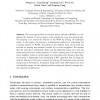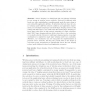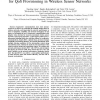1398 search results - page 185 / 280 » Energy Conservation in Reliable Wireless Sensor Networks |
108
click to vote
UIC
2007
Springer
15 years 4 months ago
2007
Springer
Abstract. The coverage problem in wireless sensor networks (WSNs) is to determine the number of active sensor nodes needed to cover the sensing area. The purpose is to extend the l...
EWSN
2009
Springer
15 years 10 months ago
2009
Springer
Sensor sleeping is a widely-used and cost-effective technique to save energy in wireless sensor networks. Protocols at different stack levels can, either individually or simultaneo...
107
click to vote
GLOBECOM
2009
IEEE
14 years 7 months ago
2009
IEEE
Abstract--Cooperative communications have been demonstrated to be effective in combating the multiple fading effects in wireless networks, and improving the network performance in ...
NETCOOP
2009
Springer
15 years 4 months ago
2009
Springer
Wireless sensor networks are designed to extract data from the deployment environment and combine sensing, data processing and wireless communication to provide useful information ...
MSN
2007
Springer
15 years 4 months ago
2007
Springer
To increase the lifespan of wireless sensor networks (WSN) and preserve the energy of sensors, data aggregation techniques are usually used. Aggregation can be seen as the process ...



